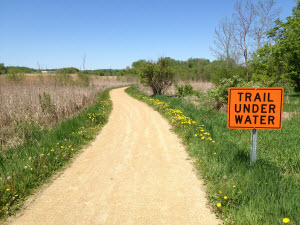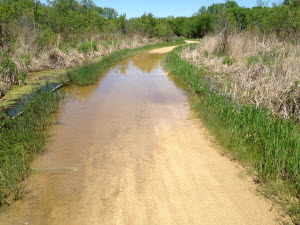
What's your strategy here?
It's a beautiful sunny Minnesota summer day here and I was enjoying it out on my old mountain bike. One of the reasons Minneapolis is as such a bicycle friendly city are the trails running everywhere. I really enjoy these smooth gravel paths because I can spend a couple hours JRA - Just Riding Along - link to a full description without any real conscious effort of watching for cars or the other things that tend to consume you when you're out in traffic.
I used JRA to describe that first ventilatory threshold, VT1. It's the place; above chatty yet below focused effort, communicating the VT1 to the students in my class. It's a wonderful place to spend a few hours and when I'm here, working aerobically, my creative juices really start flowing.
So I'm JRA, when I came upon the sign alerting me that the trail was underwater. "Oh great, now I'm going to get all wet," I thought. If you spend any time on the road or on a mountain bike, you know that a wet stripe up your back or soaked feet doesn't really add to an enjoyable time outside 🙁
I've ridden this trail for years. I realized that "trail underwater" typically means there's two or 3 inches of water from the surrounding swamp (I refuse to call it a "wet-lands"... it's a swamp), covering the trail. And I was right.
There are two strategies you can use to cross these little mini rivers, while staying as dry as possible; If the water's only a few inches deep the trick is to peddle as slowly as possible, minimizing any spray up your back. A little deeper and you'll be pedaling your feet through water, so you'll sacrifice I wet back to keep your feet dry. This requires a bit more finesse and can challenge your bike handling skills. You accelerate to the speed that you think you're going to need in order to coast all the way to the other edge, keeping your feet level, up and out of the water. Doesn't always work perfectly. You sometimes stall before the end and wind up doing a sort of rocking motion with your feet, engaging the freewheel through a small segment of the circle, hoping to propel your self forward, while keeping your feet out of the water and not falling over - which would defeat the whole exercise.

The challenge is going just slow enough.
After successfully navigating the water hazard and resuming JRA, I was thinking about how we're always talking about the maximum in class; the highest, what's your threshold heart rate, find your FTP, how long can you sustain this, etc. But we rarely try to define the other side of it... how slow or low should you go?
If you've taught for any length of time you've experience the "spinner". That person who seems to think they're accomplishing something while furiously pedaling with no resistance. Having indoor cycles with power changes that. As part of my initial orientation I give a new student, I'll have them peddle with no resistance and watch the display. On the FreeMotion bikes no resistance equals no power. And it's a wonderful illustration to help people understand the futility of peddling and not really accomplishing anything of value.
[wlm_firstname] I'm not sure that I have the whole answer here so feel free to share your ideas.
I'm a big believer that every minute of class should be of value. Just as there are times outdoors when you have to go slowly, you are being productive... still moving yourself forward.
I try to communicate this need for productivity in every class I teach. I'll frequently lament the fact that I only have them for an hour. 60 min. isn't really that long, so let's not waste our time doing nothing.
How I cue this is easier with power, but the feeling is the same. I'll have everyone start the class with zero resistance. I'll ask everyone to find a comfortable cadence and begin adding resistance. I'll explain that productivity for each of us is different, and yet if were honest with ourselves we understand when we're there. My morning classes are typically a bunch of "A" types and I'll make the comment that busy work is not the same as productive work. "Just going through the motions may give the appearance of work to others, but deep down you understand whether you're truly being productive or not."
My feelings are that riding "productively" should bring everyone to a HR near to or right at VT1 / base of Zone three in a five Zone system.
I reinforce the need for productivity at the end of the long interval. Recovery should be productive. I'll suggest to everyone that once they have recovered to the point where they feel some calm in their breathing, they need to return to that place of productivity - catching their Heart Rate at VT1 / JRA.
There'll be plenty of time, to fully recover, once we've crossed to the other side.[plulz_social_like width="350" send="false" font="arial" action="like" layout="standard" faces="false" ]
Originally posted 2012-05-22 08:58:38.
